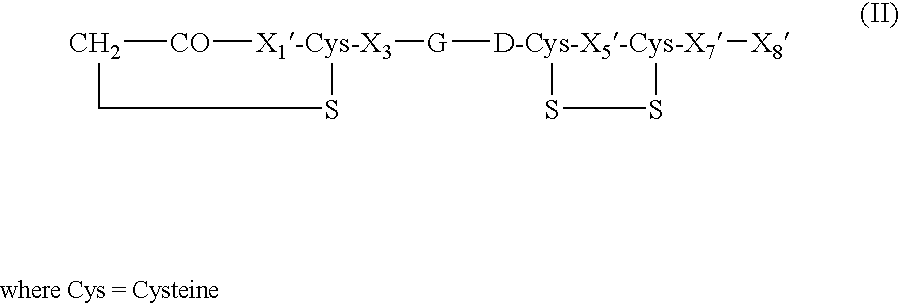Peptide-based compounds
a technology of peptides and compounds, applied in the field of peptide-based compounds, can solve the problems of insufficient supply of nutrients and oxygen to cells, inability to detect and detect abnormalities, and inability to fully absorb the peptides, etc., and achieve the effect of improving images
- Summary
- Abstract
- Description
- Claims
- Application Information
AI Technical Summary
Benefits of technology
Problems solved by technology
Method used
Image
Examples
example 1
Synthesis of compound 1
[0128]
Synthesis of technetium chelate—Pn216
a) Chloro-nitroso intermediate (3-chloro-3-methyl-2-nitrosobutane)
[0129]A mixture of 2-methylbut-2-ene (18.5 mL) and iso-amyl nitrate (19.5 mL) was stirred, cooled to −10° C. and concentrated hydrochloric acid (17.5 mL) added carefully to maintain the temperature below 0° C. The reaction was stirred at this temperature for 30 minutes. The precipitate formed was collected by filtration, washed 4×5 mL of ethanol (−20° C.) and dried in vacuo to give 3-chloro-3-methyl-2-nitrosobutane as a white solid.
b) Pn216—(3,3,11,11-tetramethyl-7-aminoethyl-4,7,10,triazamidecane-2,12-dionedioxime)
[0130]To a solution of tris-(2-aminoethyl) amine in acetonitrile (20 mL) was added sodium bicarbonate (2.2 g, 26 mmol). A solution of 3-chloro-3-methyl-2-nitrosobutane (1.8 g, 13 mmol) in dry acetonitrile was added slowly at 0° C. The reaction mixture was left to stir at room temperature for 4 hours and then filtered. The filtrant was washed ...
example 2
[Cys2-4, 8-10] analogues
a) Synthesis of C1CH2CO-Lys-Asp-Cys-Arg-Gly-Asp-Cys (tBu)-Phe-Cys(tBu)-Gly-Gly-OH (Seg. ID 2)
[0141]
[0142]The peptide was synthesised on an ABI 433A automatic peptide synthesiser starting with Fmoc-Gly-Wang resin on a 0.25 mmol scale using 1 mmol amino acid cartridges. The amino acids were pre-activated using HBTU before coupling. Final N-terminal chloroacetylation was accomplished using a solution of chloroacetic anhydride in DMF for 30 min.
[0143]The simultaneous removal of peptide and side-chain protecting groups (except tBu) from the resin was carried out in TFA containing TIS (5%), H20 (5%) and phenol (2.5%) for two hours.
[0144]After work-up 260 mg of crude peptide was obtained (Analytical HPLC: Gradient, 5-50% B over 10 min where A=H2O / 0.1% TFA and B=CH3CN / 0.1% TFA; column, Phenomenex Luna 3μ C18 (2) 50×4.6 mm; flow, 2 mL / min; detection, UV 214 nm; product retention time, 6.5 min. Further product characterisation was carried out using mass spectrometry: E...
PUM
| Property | Measurement | Unit |
|---|---|---|
| atomic numbers | aaaaa | aaaaa |
| atomic numbers | aaaaa | aaaaa |
| atomic numbers | aaaaa | aaaaa |
Abstract
Description
Claims
Application Information
 Login to View More
Login to View More - R&D
- Intellectual Property
- Life Sciences
- Materials
- Tech Scout
- Unparalleled Data Quality
- Higher Quality Content
- 60% Fewer Hallucinations
Browse by: Latest US Patents, China's latest patents, Technical Efficacy Thesaurus, Application Domain, Technology Topic, Popular Technical Reports.
© 2025 PatSnap. All rights reserved.Legal|Privacy policy|Modern Slavery Act Transparency Statement|Sitemap|About US| Contact US: help@patsnap.com



